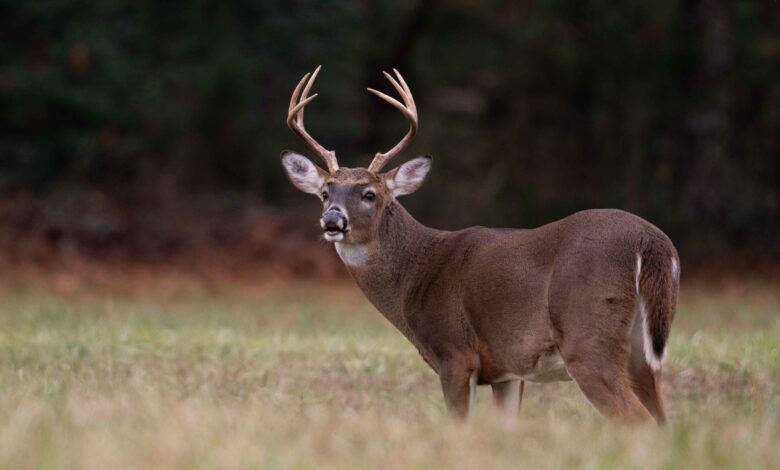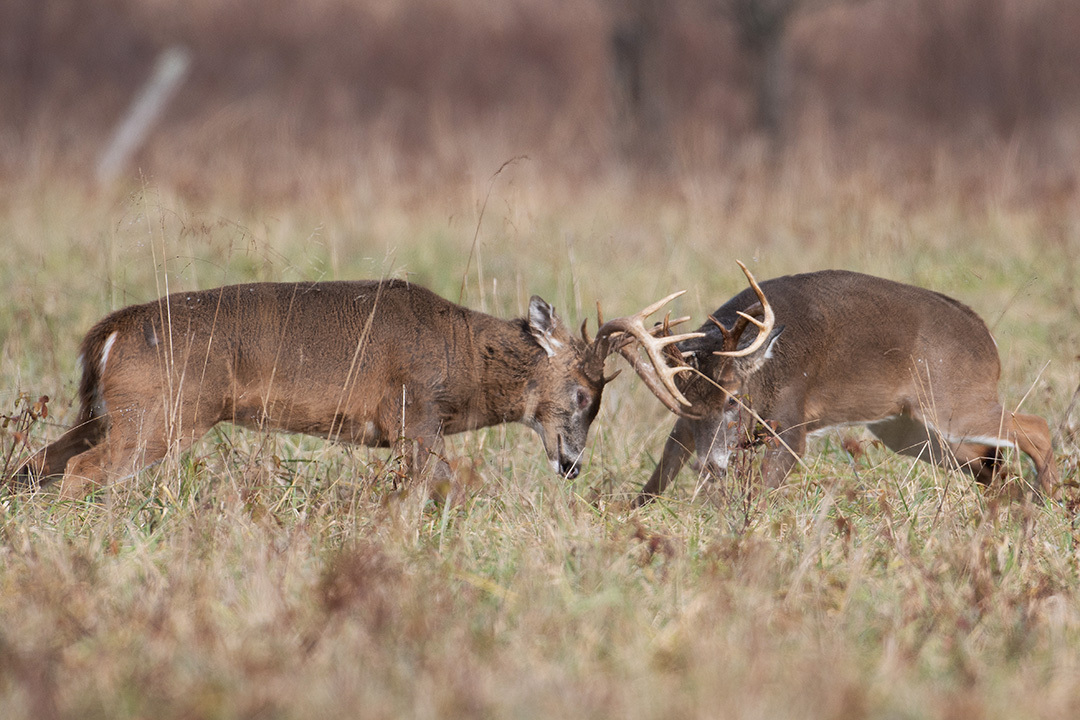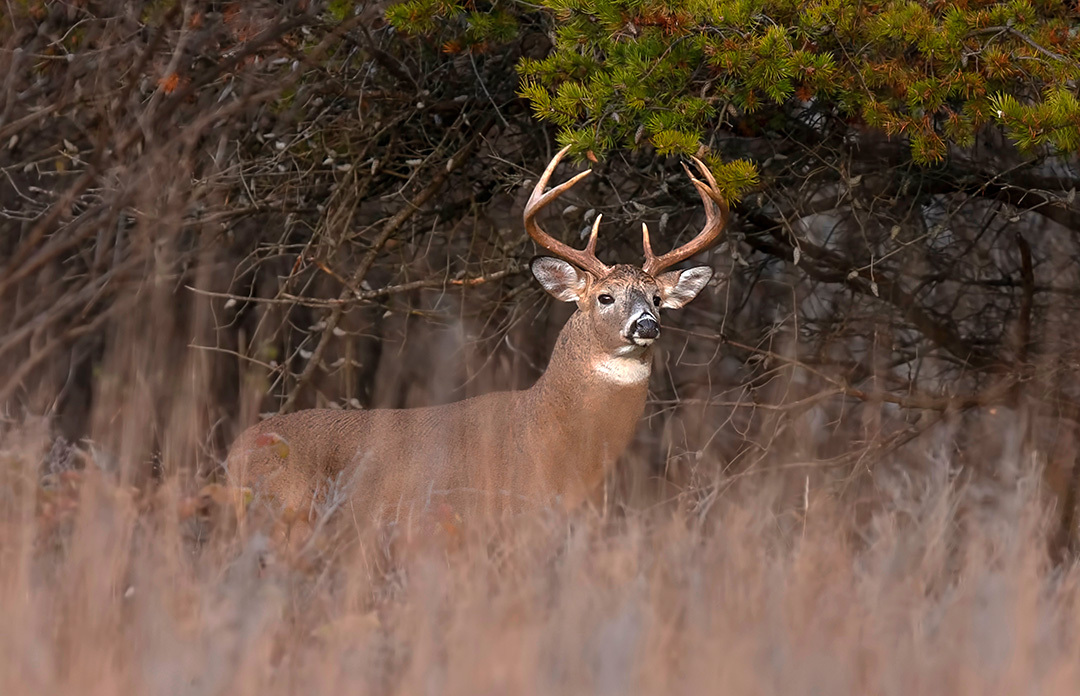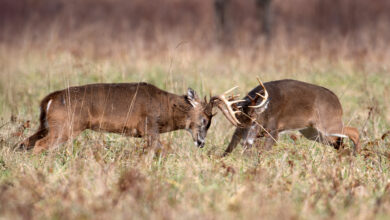Understanding and Hunting During Deer Rutting Season

The crunch of leaves underfoot echoes through bare trees, your breath crystallizing in the chilling autumn air. Fresh rubs scar tree trunks and wallows of dug earth mark territorial lines.
Then you hear it — the sharp crack of antlers colliding.
You’re in your treestand early, but you know sleepless nights are worth it during this brief window of hunting glory.
There’s an age old question seasoned hunters are trying to find a true answer to. When is deer rutting season and how long does the rut last? It’s a question that’s hard to find the right answer for.
When is Rutting Season for Deer?
Rutting season typically runs from mid-October to early December depending on your region. While the estrous cycle leading to breeding activity is triggered by shortening amounts of daylight the intensity will vary.
Generally speaking, locations in the more northern states see a fairly intense and condensed rutting period first, while more southern regions experience a more sporadic and extended timeframe.
Here’s a look at the typical look at whitetail deer rutting season:
- Far Northern States: late October to early December peak
- Midwest and Northeast: late October to late November peak
- Southeast: more variability; October through February peak periods
Understanding the differences in rut timing for your location is key to maximizing your chances during the windows of peak activity. While weather and other factors can impact deer movement, they don’t shift the cycle of seeking and chasing fate triggers in a doe’s reproductive hormones.
What Is the Rut?
Deer rutting season, or “the rut” refers to the annual breeding season for deer. Specifically, it’s when female deer, called does, enter their estrous cycle and start releasing pheromones signaling they are ready to mate.
When that scent hits the air, every buck within nose-range takes notice and starts running on hormones and instinct.
This spike in sexual activity means deer throw caution to the wind. Normally calm does dash through openings they’d normally avoid, followed by bucks single-mindedly trailing them. Even mature bucks let down their guard, being more concerned with the other suitors encroaching on their territory.
In other words, the rut is when deer just act different, making them much more visible and easier to hunt. Timing the peak of breeding activity in your region is key to having your sights set when that monster buck you’ve been chasing finally slips up.
While does go into heat for just 24 to 48 hours, the lead up and aftermath of seeking, chasing, and posturing stretch the breeding frenzy into three distinct phases: the pre-rut, peak-rut, and post rut. Understanding how deer behave differently in each period allows hunters to adapt their strategies for maximum success.
The Three Phases of Rutting Season
While a doe is only breedable for a day and a half, the behaviors of bucks prolonged over weeks as they prepare for and recover from their mating efforts. This activity crescendo and diminuendo can be broken down into three phases:
- Pre-Rut
- Peak Rut
- Post Rut
The Pre-Rut Phase
In the weeks leading up to peak breeding activity, a deer’s patterns start to shift from their mild summer routines. Days are growing notably shorter, leaving less time for feeding and leading deer to start visiting food plots and crop fields more frequently in the fading evenings.
Bucks initiate the first stirrings of what will become the rut frenzy during the pre-rut phase, as early as late September in the North.
While still focused on feeding heavily themselves in preparation for the demands of the coming weeks, mature bucks also scrape the ground bare and thrash small trees to establish the boundaries of their domain.
These behaviors offer clues the prelude to rut is approaching:
- Bucks rubbing their forehead and antlers on trees and branches
- Making scrapes on the ground where they urinate to leave their scent
- Increase in sparring between young bucks honing skills
- Elevated feeding activity in early morning and evening
Prime areas to key in on during the pre-rut phase are travel corridors connecting bedding and feeding areas. Focus on pinch points or terrain features does would naturally funnel through.
Locating fresh rubs and scrapes also betray deer haunts worth siting a treestand nearby.
Hunting tactics for the pre-rut phase:
- Saddle up on travel corridors before dawn and after dusk
- Distribute trail cameras near scrapes and rubs
- Use a scent attractant formulated for early season
- Rattle sparingly and softly
- Focus efforts near known food sources

The Peak Rut Phase
The actual mating window when does can conceive may only last 48 hours, but the build up to breeding reaches a fevered pinnacle just prior, known as the “peak rut” phase. As hunters in the Northern states flip their calendars to November, they know the woods are reaching an eruption point.
It’s during this “peak rut” window when bucks abandon all normal patterns, foregoing meals and rest in pursuit of that one hot doe whose scent promises a chance to pass on their genes. Big mature bucks emboldened by surging testosterone levels throw caution aside as they chase off subordinate competition and patrol for estrus does.
Peak rut brings three types of behaviors yielding increased buck sightings:
Seeking:
Bucks cruise more aggressively through bedroom and feeding areas trying to sniff out does coming into estrous. Expect to see bucks patrolling known doe areas and even stopping to smell spots they’ve recently crossed looking for lingering scent.
Chasing:
When a doe is ready to breed, bucks will trail her relentlessly, even throughout daylight hours. Dominant bucks run wide-eyed and reckless after dashing does, presenting fleeting but clear shots for opportune hunters.
Tending:
After breeding, bucks tend to stick close to a hot doe to ward off other suitors, spending 24-48 bedded down near her location. The woods seem to quiet down during this short lockdown period.
To make the most of the peak rut phase:
- Saddle-up all day near doe hangouts
- Rattle loudly and frequently
- Use bleats and estrus calls
- Be hyper mobile and reactionary
The Post Rut Phase
Soon the frenzy subsides, the last doe has been bred, and the sudden silence leaves many hunters feeling the party ended too soon.
Both bucks and does retreat to their survival instincts of rest and refueling after an energy-depleting few weeks.
But the post-rut phase spanning November to December still offers chances at interceptions:
- Bruiser bucks can still be tempted by a late doe entering estrus
- Youth bucks feeling their oats for the first time may still harass does
- Rutted bucks exhausted and run down after chasing does make mistakes
Shifting tactics to key on late-season mindsets can still offer solid success:
- Setup on food sources bucks are trying to replenish energy
- Focus on heavy cover where deer will bed in recovery
- Use attractants to lure in fatigued deer
- Rattle sparingly
- Be ready to take cross-property pot shots at unsuspecting bucks

Regional Deer Rut Hunting Forecast
Beyond the general phases, the week-by-week progression of behaviors during the rut can vary slightly across the whitetail’s range. Here’s a regional hunting forecast highlighting the prime windows noted by guides and experts when monumental things tend to happen in the timber:
Northeast Deer Rut Hunting Forecast
Last week of October:
Full moon supercharges movement near rubs and scrapes
November 7 – 12:
Peak breeding drives seeking and chasing; activity hits fever pitch
November 22 – 24:
Check hot does for late estrous kickstarting final cycle; fatigued giants make mistakes
Midwest Deer Rut Hunting Forecast
Last week of October:
Rain drives cruising and sparring; bucks transition toward peak ranges
November 9 – 15:
Mature bucks reckless and responsive to calls; prime for intercept opportunity
Late November:
Stick with them – some shooters still courting does while others vulnerable grazing depleted food plots
Southeast Deer Rut Hunting Forecast
October through November:
Earlier pre-rut signs showing up; patterns starting to shift
Early to mid December:
Cooler weather gets deer on their feet after spotty November rutting; late estrous does bring mature bucks out
Late December to January:
Bucks worn down and focused on recovery; intercept along corridors between food sources.
While the descriptions may vary slightly around the edges from Alabama to Maine and Kentucky to Iowa, the song remains relatively the same year in and year out. Every fall inevitably brings the swell of surging testosterone levels and daylight dementia in which seasons are made.
Rut Reality Check
While research continues to prove true biology is responsible for timing the estrous cycle, so much rut lore still circulates around scrapes under crescent moons. But here are a few myths busted by modern science:
- Early cold snaps don’t kick bucks into breeding overdrive prematurely; decreasing daylight governs the cycle
- The “October Lull” is just pre-rut transition, not lack of activity
- While weather impacts deer behavior day-to-day, nothing alters the prime rut dates long proven out
- There’s no substitute for seat time during peak activity periods you narrow down for your location
So don’t drive yourself crazy with apps predicting some magical day the woods will erupt if you aren’t out there to capitalize.
Instead, arm yourself with general knowledge of deer biology so you know what to expect. Then get blinker fluid in your truck and blaze a trail to your heated box blind to bask in the glowing madness for yourself.
Because when November rears her fickle head, the primetime activity you inconveniently schedule your life around faithfully arrives as punctual as the harvest moon rise. And for the dedicated whitetail fanatic, that’s straight up nirvana. Enjoy!




